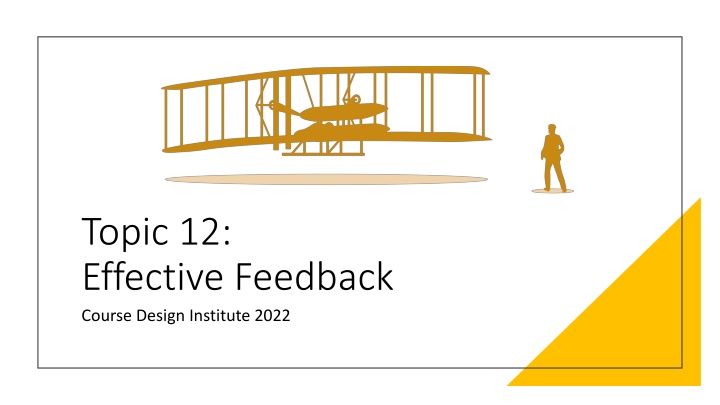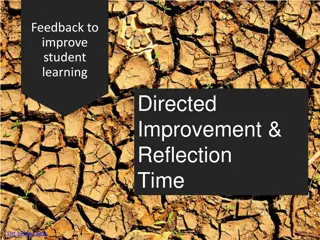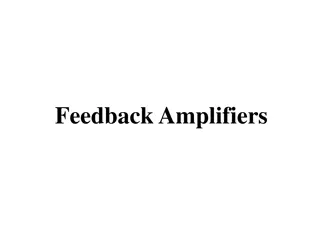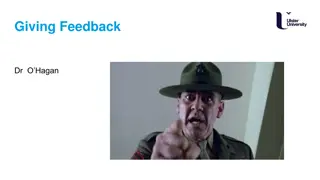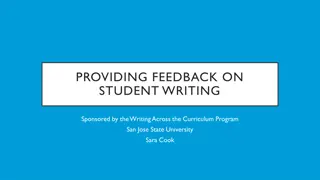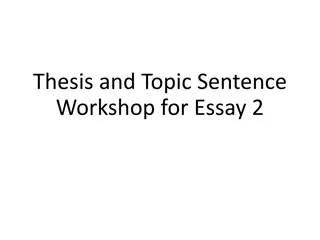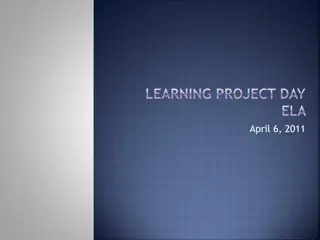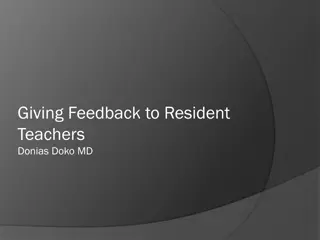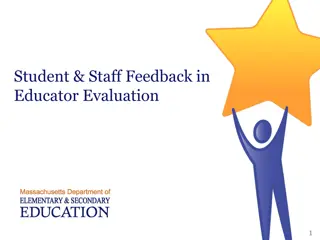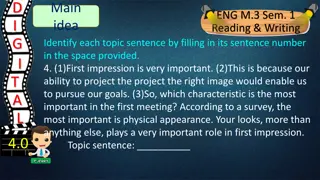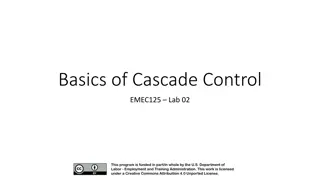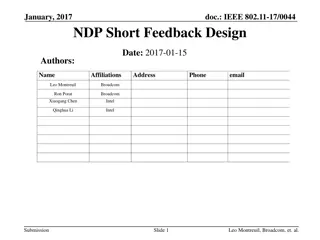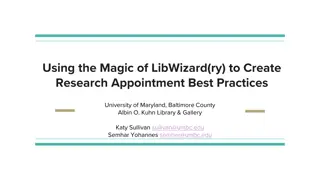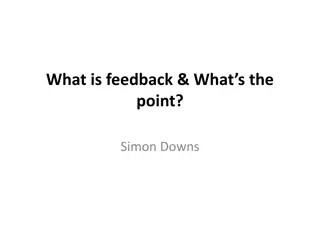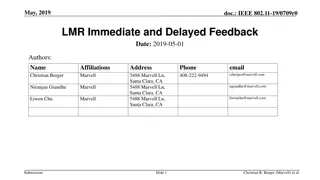Topic 12: Effective Feedback
Providing effective feedback and critique is crucial in academic settings to help students identify strengths, weaknesses, and areas for improvement. The process involves recognizing successes, suggesting improvements, and establishing a personal connection with students. Feedback aims to offer constructive guidance without being overly negative, fostering a supportive learning environment.
Download Presentation

Please find below an Image/Link to download the presentation.
The content on the website is provided AS IS for your information and personal use only. It may not be sold, licensed, or shared on other websites without obtaining consent from the author.If you encounter any issues during the download, it is possible that the publisher has removed the file from their server.
You are allowed to download the files provided on this website for personal or commercial use, subject to the condition that they are used lawfully. All files are the property of their respective owners.
The content on the website is provided AS IS for your information and personal use only. It may not be sold, licensed, or shared on other websites without obtaining consent from the author.
E N D
Presentation Transcript
Topic 12: Effective Feedback Course Design Institute 2022
Feedback and Critique Instructors in creative disciplines regularly provide feedback to students about their creative work, usually through informal meetings with individual students or more formalized group critique sessions. This process can also apply to student writing, presentations, or performance tasks in any discipline.
Why give feedback? Evaluation is crucial in every academic area, including substantive diagnosis of the strengths and weaknesses of the student s work. However, there is no reason to engage in destructive or disheartening negativity. Assessment should not be sugar coated, but it should also not be an exercise in oppositional contrarianism nor a condemnation of every flaw in the student s work. The primary goal of any assessment should be an honest appraisal of a student s learning relative to a given academic task. Feedback gives students a chance to learn what they did well and where they can improve.
Three-Part Feedback Recognize Success Begin with a statement about what was good in comparison to the entire project. What was the best thing you noticed? Suggest Improvement Phrasing criticism as suggestions for improvement helps students receive your comments without becoming defensive. Instead of saying, This was wrong a statement like, This could be even better if you puts students in a more receptive frame of mind. Personal Connection Ask a question about how they completed the work Share a personal example Provide references or helpful materials Offer additional assistance to make the work better
Example: The Backstory Students in a nonprofit management course were asked to find an organization where they could apply for a grant. The assignment included conducting research into the selected granting organization, and to write a three-page letter of inquiry for this grant utilizing a planning template provided by the instructor. The paper was to be formatted according to specific requirements for a business letter, which were provided in a printed handout. When explaining the project, the instructor emphasized that attention to detail was crucial, as was creating a concise, convincing, and professional product following the granting organization s specifications, including submission by the stated due date.
Example: The Students Work To Whom It May Concern, I am writing to inquire about whether your organization would be willing to provide a lot of money to turn a vacant lot near a downtown elementary school into a playground because all the school has is pavement all around it and nothing for kids to play on. The land belongs to the city and is available for us to do this project, if we can get funding and enough volunteers to make it happen. This project will bring community members, university students, and the members of the school s staff and parents together to build the playground. We are an all-volunteer group and we really need the money in order to buy the materials and rent the heavy equipment that will be necessary to get the job done. I know that I m submitting this after the due date for this grant, but I really hope that you will be able to give us these funds anyway. We re a small group of all volunteers and none of us know much about how this process works. We also don t know yet how much money we ll need. We ll be able to figure this out after we get started, but we thought that maybe we could build our budget around the amount you might be willing to give us? Thanks so much for thinking about our request. We really need this money if our project is going to succeed. I hope that we ll hear from you soon. Sincerely, [student name]
Example: The Explanation Obviously, this student s work has quite a few problems. The letter is far too short, too vague, and too casual, among many other flaws. In fact, the instructor s justifiable first reaction might be to fail the student outright, since this paper did not come close to meeting the assignment requirements. A better approach would treat this assignment as a first draft and provide concrete feedback giving the student explicit instruction into how to improve the letter in order to meet the assignment requirements successfully the second time around.
Example: The Feedback Formula Key: (1) begin with a positive comment, (2) suggest improvement, and (3) make a personal connection. (1) Thank you for submitting your grant inquiry letter. I think that the collaboration between your organization, university students, and the elementary school is a very promising idea. (2) However, your letter needs more detail in order to both meet the assignment requirements and to develop its potential to convince the granting organization that this is a meritorious proposal. (3) First, I d like you to consult the writing guide I provided for this assignment and to compare those instructions to the document you submitted. Then I d like to schedule a meeting with you where we can go over the criteria for the proposal and we can address the other areas of your letter that need revision. I m happy to help you revise your letter, but as it stands, I m unable to give you a passing score if you choose not to make these changes. I would be available to meet with you during my office hours after class on Thursday. This approach validates the student s initial efforts and basic idea but leaves no doubt that the assignment is presently unacceptable. It also includes an offer of support so that the student can become more successful in the task upon revision.
LBNT+ LBNT+ Students can use the LBNT method to assess their own work and the work of their peers. Self Assessment: LBNT LB = Like Best What did the student like best about his or her own work? NT = Next Time If given the chance, what would the student do differently the next time? Peer Evaluation: LBNT+ LB = Like Best What did you like best about your classmate s work? NT = Next Time If given the chance, what would you suggest the student do differently the next time? + = Plus What other words of advice or encouragement could you share with your classmate? What personal connection might you make?
Informal Feedback and Interactions with Students Educators provide feedback to our students all the time, even when we re just answering a question. The way we respond to our students has a tremendous impact on their learning experience. Let s look at this through several scenarios, considering two ways faculty could react that either fosters learning or shuts it down.
Scenario 1: Student Email Response Student A sends the faculty member an email asking for clarification about how to format a paper. The faculty member is somewhat annoyed with the student s question, since the question clearly indicates that the student could not have read the instructions that were provided. Poor Response: The faculty member sends a curt reply: Full instructions for this assignment were provided in the course syllabus.
Scenario 1, continued Better Response: The faculty member replies to the student s email, saying, The answer to your question can be found in our course syllabus, where complete directions for the paper are provided on page 15. In answer to your question, though, the paper should be written according to MLA guidelines, including a heading, works cited page, and footer with your full name and page numbers. If you need help with MLA formatting, you might want to check in with the campus writing center, or you can try the OWL at Purdue at https://owl.english.purdue.edu/owl/resource/747/01/ Why this is better: this response reminds the student of the original expectation but also addresses his concern directly and provides additional information that might help the student to be successful.
Scenario 2: Late Work Student B fails to turn in an assignment in an online class. Poor Response: The faculty member marks the assignment as a zero. Better Response: The faculty member sends Student B an email, saying, Dear B, I see that you did not submit the assignment that was due on Monday. If you have questions about this assignment, or if there s any information I can provide that might help you to complete it, please let me know.
Scenario 2, continued Why this is better: The faculty member would certainly be within their rights to simply mark the missed assignment as a zero. Reaching out to the student and offering to help is a more compassionate choice and more likely to result in the student doing the work. If the student does not reply, the faculty member should also take the next step of informing the student s academic advisor of the problem.
Scenario 3 Student C constantly interrupts class to ask questions or provide very opinionated remarks about the course content. Poor Response: The faculty member begins to ignore Student C in class, refraining from calling on him when he raises his hand and changing the subject without responding to his comments.
Scenario 3, continued Better Response The faculty member asks Student C to stay after class one day, inviting him to sit down and discuss his classroom behavior. This could include something like this: I m really glad to see that you re so engaged in our class, C. But it seems to me that your contributions are edging other students out of the conversation. I m happy to continue these discussions with you after class, but I d like for you to try to tone down your rhetoric a bit so that other students still feel like there s room for their own questions or comments. I d like to make a private agreement with you that I ll call on you no more than three times during the class period. Does this seem reasonable? Why this is better Ignoring the problem student will not cause his behavior to change. The student may be unaware that he is a disruptive influence in the classroom, so bringing the problem to his attention is a good first step. Further, having this discussion privately rather than calling the student out for the bad behavior in front of the other students is more respectful and therefore more likely to meet with the desired result.
Scenario 4 Student D is frequently late for class, remains silent during discussions, and has difficulty staying awake during lectures. Poor Response: The faculty member penalizes Student D s class participation grade but does not say anything to the student, choosing to ignore the behavior.
Scenario 4, continued Better Response: The faculty member sets an appointment with Student D during office hours, during which they describe his behavior and its impact on the other students, remind him that this could affect his grade, and ask for his explanation about why this has been happening. When Student D explains that he has been very tired because of working the late shift in the computer lab, the faculty member offers help him strategize ways to maximize his schedule given the conflicting demands of expectations of his work and his classes. Why this is better: Although it s easy to just mark a student down for these behaviors, attempting to find the cause of the problem is more likely to result in a solution. If the conversation does not resolve the problem, it might be wise to seek the input of the student s academic advisor, who could move the student to a different section of the course, or who could advocate for a change in the student s work schedule so that he s not so exhausted in class.
Pair and Share 1. Decide who will be Partner A and who will be Partner B. 2. Partner A: tell Partner B about a specific experience you ve had as an educator inspired by the scenarios we ve discussed. 3. Partner B: suggest to Partner A how they might use some of the strategies we ve discussed when encountering a similar teaching problem. 4. Switch roles and repeat the exercise.
Group Discussion What questions or concerns do you have about delivering feedback to students? How do you think you might incorporate some of these strategies into your teaching? Student self-assessment using LBNT Peer critique using LBNT+ Using three-part feedback with student work that can be revised and resubmitted Other ideas?
